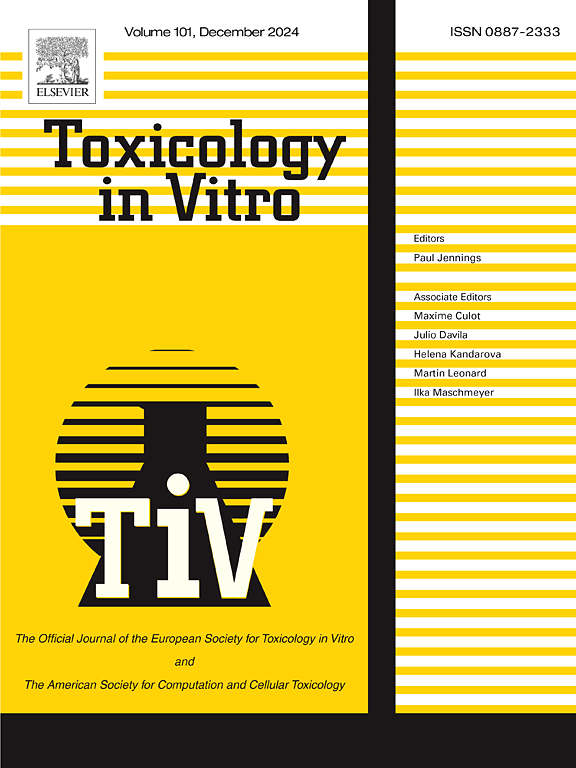Sinapic acid alleviates glutamate-induced excitotoxicity by inhibiting neuroinflammation and endoplasmic reticulum stress pathway in C6 glioma cells
IF 2.6
3区 医学
Q3 TOXICOLOGY
引用次数: 0
Abstract
Sinapic acid (SA) is a polyphenol compound derived from hydroxycinnamic acid found in various foods such as cereals and vegetables and has antioxidant, anti-inflammatory and neuroprotective properties. However, its effects on glutamate-induced excitotoxicity, which is important in neurodegenerative diseases, have not been fully elucidated. This study aimed to investigate the effect of SA on glutamate excitotoxicity and the possible role of proinflammatory cytokines and the endoplasmic reticulum (ER) stress pathway. In the study, C6 rat glioma cell line was used and the cells were divided into 4 groups: control, glutamate, SA and glutamate+SA. Cells were treated with 10 mM glutamate for 24 h to induce excitotoxicity. Additionally, SA was applied to cells at concentrations of 12.5 to 100 μM to examine its effects on glutamate excitotoxicity. XTT test was used for cell viability, and apoptotic cells were determined by immunofluorescence and flow cytometry methods. Proinflammatory cytokines (tumor necrosis factor-alpha, TNF-α and interleukin-beta, IL-1β), ER stress markers (glucose regulatory protein 78, GRP78; C/EBP homologous protein, CHOP and activating transcription factor-4, ATF-4) and caspase-3 was used to measure ELISA method. Findings indicated that SA (50 μM) significantly increased cell viability against glutamate-induced excitotoxicity (p < 0.05). Also, SA caused a significant decrease in TNF-α, IL-1β, GRP78, CHOP, ATF-4 and caspase-3 levels in glutamate-treated cells (p < 0.05). Flow cytometry and immunofluorescence staining results showed that SA reduced apoptosis in C6 glioma cells. In conclusion, our findings suggested that SA attenuated glutamate-induced excitotoxicity by preventing apoptosis through reducing proinflammatory cytokines and ER stress protein levels.
辛酸通过抑制C6胶质瘤细胞的神经炎症和内质网应激途径减轻谷氨酸诱导的兴奋性毒性
辛酸(SA)是一种从羟基肉桂酸中提取的多酚化合物,存在于谷物和蔬菜等各种食物中,具有抗氧化、抗炎和神经保护作用。然而,其对谷氨酸诱导的兴奋性毒性的作用,在神经退行性疾病中是重要的,尚未完全阐明。本研究旨在探讨SA对谷氨酸兴奋毒性的影响,以及促炎细胞因子和内质网应激途径的可能作用。本研究采用C6大鼠胶质瘤细胞系,将细胞分为对照组、谷氨酸组、SA组和谷氨酸+SA组。用10 mM谷氨酸处理细胞24 h诱导兴奋毒性。此外,将12.5 ~ 100 μM的SA作用于细胞,观察其对谷氨酸兴奋毒性的影响。采用XTT法检测细胞活力,免疫荧光法和流式细胞术检测凋亡细胞。促炎因子(肿瘤坏死因子-α, TNF-α和白细胞介素- β, IL-1β),内质网应激标志物(葡萄糖调节蛋白78,GRP78;ELISA法采用C/EBP同源蛋白、CHOP和活化转录因子-4 (ATF-4)、caspase-3检测。结果表明,SA (50 μM)可显著提高细胞抗谷氨酸诱导的兴奋性毒性(p <;0.05)。此外,SA引起谷氨酸处理细胞中TNF-α、IL-1β、GRP78、CHOP、ATF-4和caspase-3水平的显著降低(p <;0.05)。流式细胞术和免疫荧光染色结果显示,SA可减少C6胶质瘤细胞的凋亡。总之,我们的研究结果表明,SA通过降低促炎细胞因子和内质网应激蛋白水平来防止细胞凋亡,从而减轻谷氨酸诱导的兴奋毒性。
本文章由计算机程序翻译,如有差异,请以英文原文为准。
求助全文
约1分钟内获得全文
求助全文
来源期刊

Toxicology in Vitro
医学-毒理学
CiteScore
6.50
自引率
3.10%
发文量
181
审稿时长
65 days
期刊介绍:
Toxicology in Vitro publishes original research papers and reviews on the application and use of in vitro systems for assessing or predicting the toxic effects of chemicals and elucidating their mechanisms of action. These in vitro techniques include utilizing cell or tissue cultures, isolated cells, tissue slices, subcellular fractions, transgenic cell cultures, and cells from transgenic organisms, as well as in silico modelling. The Journal will focus on investigations that involve the development and validation of new in vitro methods, e.g. for prediction of toxic effects based on traditional and in silico modelling; on the use of methods in high-throughput toxicology and pharmacology; elucidation of mechanisms of toxic action; the application of genomics, transcriptomics and proteomics in toxicology, as well as on comparative studies that characterise the relationship between in vitro and in vivo findings. The Journal strongly encourages the submission of manuscripts that focus on the development of in vitro methods, their practical applications and regulatory use (e.g. in the areas of food components cosmetics, pharmaceuticals, pesticides, and industrial chemicals). Toxicology in Vitro discourages papers that record reporting on toxicological effects from materials, such as plant extracts or herbal medicines, that have not been chemically characterized.
 求助内容:
求助内容: 应助结果提醒方式:
应助结果提醒方式:


